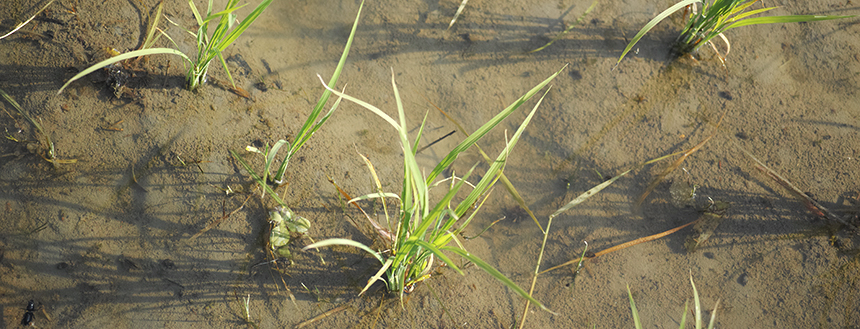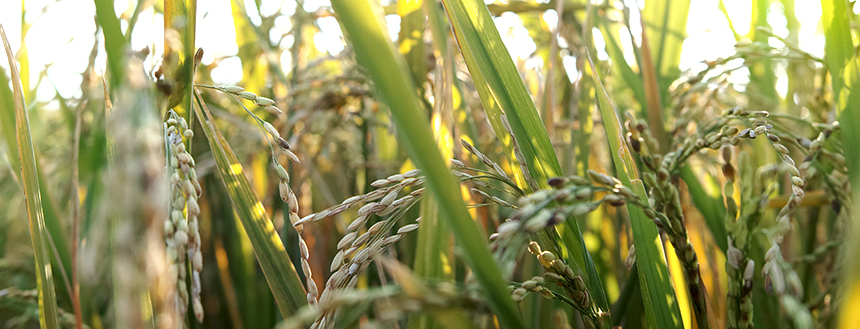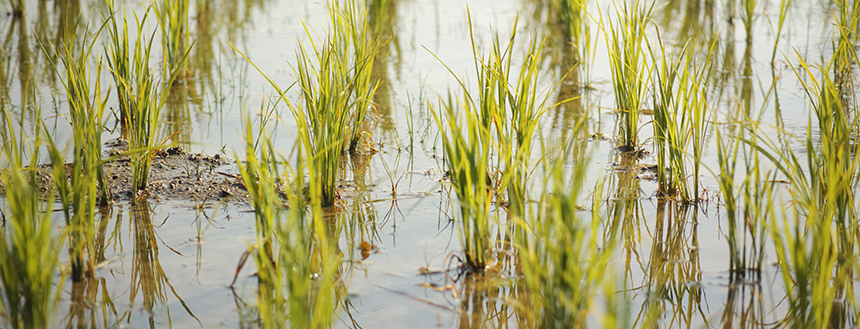

R3BY(2021)
In May 2021, monthly rainfall was high and monthly sunshine hours were short, but the monthly average temperature wasn’t low so rice planting was carried out in favourable conditions.
In June, the rice grew steadily thanks to the fact that there was little rainfall, with only about 60% of the normal amount, and the sunny days continued.
July continued to be a hot month with little rain and many sunny days. The limited rainfall was an advantage for the growth of the rice plants as it was a time to strengthen the roots by draining the water from the rice fields and drying it.
August turned into a month with a lot of rain and little sunshine. However, the sunshine returned at the end August.
Although there were many cloudy days and little sunshine in September, the rainfall itself was normal. In recent times, there have been many years of high temperature damage during the ripening period of the rice plant, but in September of this year, the night temperature dropped due to the number of cloudy days, and the ripening of rice remained in an ideal environment.
Typhoons 14 and 16 passed through, but did not cause a big problem as they did not hit directly.
The harvest season in October was perfect with few rainy days, low temperatures and sunny days.
As for the final quality of sake rice, not only the quality without the high temperature damage, which is rare in recent years, but also the yield, was ideal.
As the night temperatures in September dropped, the quality of the rice starch was good, so the taste was widespread, and I feel that the sake produced was round and soft.
Of course, even in sake brewing, I had the impression that the sake rice produced in 2021 was easy to handle and was finished in a straightforward manner. Also, since the characteristics of each variety of rice were clear, it was a fun year to understand the individuality of each variety.
- R2BY(2020)
-


In May 2020, the monthly sunshine hours were quite long and the monthly rainfall was low. Rice planting was carried out in favorable conditions. Thanks to Lake Biwa, Shiga Prefecture has access to abundant water, so there wasn’t the situation of lack of water. And the climate provided for very good rooting of rice.
In June, the temperature changed rapidly between high and low, but there were enough sunshine, so no problem with the growth of rice.
July was a month with many rainy days and extremely little sunshine. As in the previous year, it was important in this period to limit the growth of the rice plant by draining the water from the field, otherwise the plant could weaken and produce too many ears, but still the field must remain moist. Although there was little sunshine, we still achieved strong growth through correct rice field management. There was also no threat of typhoon, the first time in observed history that this has happened.
In August, there were more cloudy and rainy days than in normal years, and there were concerns about diseases such as blast. Although the temperature was higher than normal, it was not as abnormally high as in 2019 and the growth was generally favorable, because there was no typhoon.
As the hot days continued in September, the sunshine returned and there were many sunny days, and the quality of starch in sake rice was improved after an ideal ripening period.
The harvest time in October was almost unproblematic, and it was a rare year that was almost unaffected by typhoons.
Regarding the final quality of sake rice, it is great compared to 2017-2019, when we experienced difficult years due to the unusual heat of August and September.
The 2020 rice was very easy to handle, even in sake brewing. Brew work ran smoothly with normal operations, making it easy to care for the sake mash without any special ingenuity. This ease of production has determined the taste of the sake and made it soft and smooth. I can feel that all of our 2020 sakes have become rich and round in taste.
- R1BY(2019)
-


In May 2019, the duration of sunshine were fairly long and the monthly precipitation was low.
In June, rice planting was carried out under a favorable condition. Less affected by Japanese rainy season “Tsuyu”. Thanks to Lake Biwa, Shiga Prefecture has abundant water from the lake so there wasn’t the situation of water lack. And the climate made rice rooting active.
In July, it was cloudy, humid and rainy for many days so the duration of sunshine were quite short. In addition, typhoons Nos. 5 and 6 came in succession so the precipitation was quite high. The average monthly temperature has dropped for the first time in last four years since 2015 due to many cloudy days. Basically this period is important for rice plants to be limited increase of number of stumps by drain but the rice field had to remain moist. It caused rice weaken and having unnecessary or too much ears.
August was a record heat. Ears of Yamadanishiki rice was growing inside stumps. The Indian heat characterized our Yamadanishiki unique. Especially the first half of August made poor pollination, which seemed to prevent normal growth of pollen in the ears because the night temperature did not drop.
September continued to be hot days, which reduced the quality of starch in sake rice. What's worse, big typhoon hit Japan continuously, and the wind and rain made the quality of rice difficult.
In October, the harvest season remained almost without problems.
As a result 2019 was a difficult year about yield and quality.A careful selection of rice was needed. Plus several efforts in sake making period was also needed. We are sure that this year sake got good aromas and a subtle sweetness define this as a delicately finessed sake, yet with an underlying power.
This elegant sake is enjoyable now.



